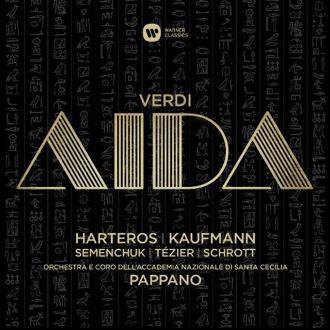|
|
|
|
|
|
|
|
| El Mercurio |
| Juan Antonio Muñoz H. |
|
Pappano’s extraordinary “Aida”: Radames, Radames, Radames !
|
|
 Leading
the choir and orchestra of l’Accademia Nazionale Santa Cecilia, which he
conducts since 2005, Antonio Pappano creates a sound space without frontiers
where voices can live in intimacy and also in midst of the masses (few
operas have as many “asides” as this one), thus accepting the difficult
mixture proposed by the score which is so hard to balance. His conduction
enthralls us with the colorful encounters, the haziness, the internal
vibration and constant unrest of the atmosphere. If the scene at the Temple
of Vulcan —extremely well accomplished— puts all this together in the
contrasting levels of heroism and prayers, the preludes to Acts I and III
lead us to an iridescent musical environment that takes us through
undulating roads towards sensuality, mysticism and human passions that here
come into play, both frantic and subterranean. The building constructed by
Pappano has an architecture full of details that suddenly converge on a hall
of amplified sound. Leading
the choir and orchestra of l’Accademia Nazionale Santa Cecilia, which he
conducts since 2005, Antonio Pappano creates a sound space without frontiers
where voices can live in intimacy and also in midst of the masses (few
operas have as many “asides” as this one), thus accepting the difficult
mixture proposed by the score which is so hard to balance. His conduction
enthralls us with the colorful encounters, the haziness, the internal
vibration and constant unrest of the atmosphere. If the scene at the Temple
of Vulcan —extremely well accomplished— puts all this together in the
contrasting levels of heroism and prayers, the preludes to Acts I and III
lead us to an iridescent musical environment that takes us through
undulating roads towards sensuality, mysticism and human passions that here
come into play, both frantic and subterranean. The building constructed by
Pappano has an architecture full of details that suddenly converge on a hall
of amplified sound.
Pappano also sustains the implicit theater of
voices, core of this artistic force that is opera. Anja Harteros is not the
spinto soprano one has in mind for Aida, on account of a somewhat narrow
middle, but her Ethiopian princess is perfectly well designed. Her careful
song joins the versatility of her accents, through which she manages to
capture the confusion of the character, her anguish, her haughtiness. She
outlines a fearful Aida, a contradictory lover who betrays, at times
treacherous, at times angelical. Formidable rival in the plot and also in
the vocal and scenic proficiency, Amneris is the opulent and vigorous mezzo
Ekaterina Semenshuck, with low tones that are a public menace with lewd
emphasis and who knows how to make the transition from the anger of the
working class to the impotence of one who cannot make herself loved.
Baritone Ludovic Tézier is a fine singer incapable of attempting against
music, and therefore his Amonasro never shouts; his fierceness is never
histrionic. He is successful even when he transfers ambiguity to this loving
father who is, above all, an uncompromising and inflexible king. Bass Erwin
Schrott isn’t Nicolai Ghiaurov or Matti Salminen, but serves with authority
as Ramfis. One must pay attention to the Sacerdotessa played by Eleonora
Buratto, whose current repertoire includes Adina (L’Elisir d’Amore) and
Micaela (“Carmen”), but perhaps may someday sing the main role of this opera
( a truly fledgling spinto?).
In the vocal level, the greatest
success of this version is the Radames of Jonas Kaufmann, dramatic and
lyrical alike, more of a lover than a hero, himself controversial. The great
German tenor knows how to reconcile ardor and refinement, and —artist of a
superior level— manages to instill into the optimism of his character
worrying and dark forebodings. His “Celeste Aida” is anthological due to the
impalpable abandonment of his singing and the B flat dreamt of by Verdi, in
mezza voce and morendo, conveniently avoided by most tenors. His whole
performance —beyond the depth of his low tones and the insolence of his high
tones— is a fabric of details and inflections, such as the diminuendo
introduced in “il ciel de’ nostri amori come scordar potrem?”, or that sweet
half-voice with which he travels over “O terra addio” with Harteros.
|
|
|
|
|
|
|
|
|
|
|
|
|